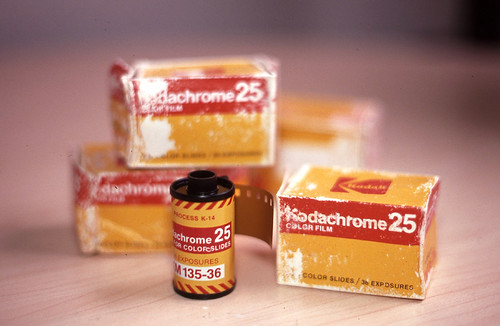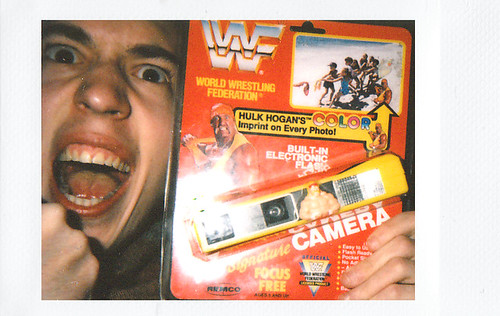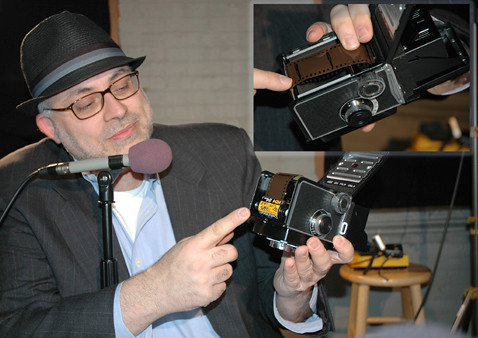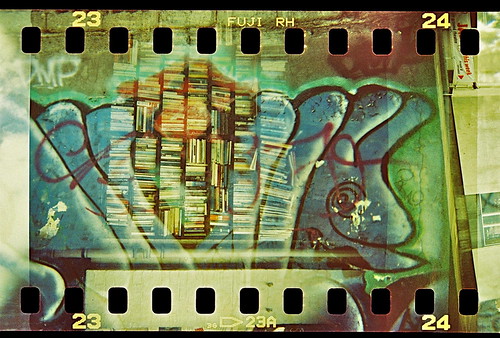
Kodachrome no more, 110 film format, sprocket hole photography, black & white home development, camera giveaways and much more. Hosted by Michael Raso, Duane Polcou and special guest John Fedele
Stream, Download or iTunes / Zune feeds
http://filmphotographypodcast.com
SHOW NOTES:
The last days of Kodachrome

Michael, Duane and John discuss the last days of Kodak Kodachrome
Kodachrome in 2011 – Shoot and develop as Black & White
According to the folks at Blue Moon Camera, Kodachrome contains an extra layer that will “gunk up” during BW development, sticking to the film causing some emulsion loss. Develop Kodachrome (as BW) in its own tank so not to contaminate other film stocks.

above: poorly stored Kodachrome 25 processed as black & white
AGFA APX BW Film Giveaway
We are giving away two sets of film. Two winners will receive 3 rolls of film each. One roll of Agfa APX 25 BW, one roll of Agfa APX 100 BW and one roll of Agfa APX 400 BW.
To enter this contest, send your name, mailing address and tell us a little about your film photography) to FilmPhotographyPodcast@gmail.com

Image © by FPP listener Dan Domme on Agfa APX 400
http://www.flickr.com/photos/yeknom02/
Ciro-Flex 120 TLR / Developer Giveaway
We are giving away a Ciro-Flex camera, 120 film and Rodinal equivalent developer.
To enter this contest, send your name, mailing address )and tell us a little about your film photography) to FilmPhotographyPodcast@gmail.com
Fuji Instax WIDE 200 Camera Giveaway
We’re also giving away the Fuji Instax Wide 200 camera.

Image by FPP listener Shaun Keenan
http://www.flickr.com/photos/shaunkeenan/
To enter this contest, send your name, mailing address and tell us a little about your film photography) to FilmPhotographyPodcast@gmail.com
EV – Exposure Value
“In photography, exposure value (EV) denotes all combinations of a camera's shutter speed and relative aperture that give the same exposure. The concept was developed in Germany in the 1950s (Ray 2000, 318), in an attempt to simplify choosing among combinations of equivalent camera settings”
http://en.wikipedia.org/wiki/Exposure_value
110 Film Photography
Michael discusses the 110 film format.

FPPer Joe Kolbek with the 110 Hulk Hogan camera. It promises an image of Hulk Hogan on every frame!
Book of the Month
“The Grand Tour” Photographs by Dick Arentz
http://www.dickarentz.com/

Shooting Sprocket Photography!

“Sprockets!”
Photo by Duane Polcou

Image © by FPP listener Justin De La Ornellas
http://www.flickr.com/photos/ornellas/
“Sprocket hole photography is a style of photography that exposes the full width of 35 mm film, creating a photograph punctuated by the "sprocket holes" (perforations) along the edges of the film.”
http://en.wikipedia.org/wiki/Sprocket_hole_photography

Image by FPP listener 25ThC
http://www.flickr.com/photos/25thc/

Image © by FPP listener Clifford Davis
http://www.flickr.com/photos/48652922@N04/
Black & White home development
Duane Polcou discusses developing Black & White negatives at home

Image developed at home by FPP listener Greg Zauswoz
Ilford HP5 plus 400
Rodinal 1+50 11min @ 20C
http://www.flickr.com/photos/43520295@N08/
The FPP 2011 Calendar

Have your very own full-color FPP calendar. Your donation is greatly appreciated.
http://filmphotographypodcast.com/donate.php
Happy New Year! See you in two weeks!
- Michael Raso & the FPP Guys
http://filmphotographypodcast.com/
The mess of developing Kodachrome as black and white film is the remjet backing, just like motion picture film. If you develop it at home in a daylight tank you can use a slight base prewash before developing. You can use tissues or a sponge to remove the remjet off the back of the film. I do it when it's hanging over my shower so I can rinse the remjet that dripped off into the tub away. Anybody who has used movie film in their still camera and then developed it at home should have no problems.
ReplyDeleteMichael
Your show is the coolest thing on the internet!
ReplyDeleteGood show but I feel taking about the zone system in the segment on film developing at home may have been a little complicated for people who have never developed before.
ReplyDeleteCheers! Dave.